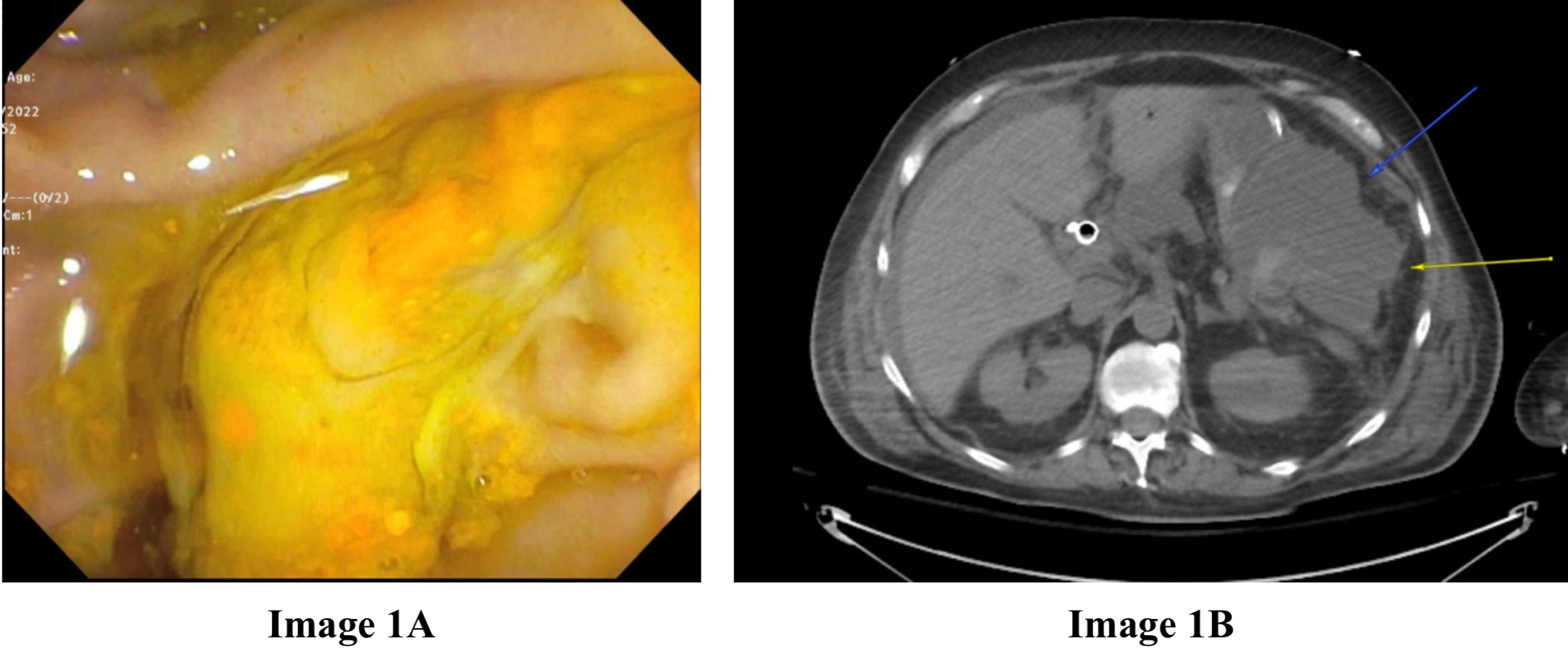Back


Poster Session C - Monday Afternoon
Category: Interventional Endoscopy
C0477 - Post-ERCP Greater Curvature Hematoma Complicated by Polymicrobial Infection: Case Report and Literature Review
Monday, October 24, 2022
3:00 PM – 5:00 PM ET
Location: Crown Ballroom

Has Audio

Michelle H. Kwon, MD
Warren Alpert Medical School of Brown University
Providence, RI
Presenting Author(s)
Michelle H. Kwon, MD, Daniel Marino, MD, MBA, Nhu Dang, BA, Kanhai Farrakhan, MD
Warren Alpert Medical School of Brown University, Providence, RI
Introduction: ERCP has become critical in diagnosing and treating biliary and pancreatic diseases. ERCP-related complications occur in 2.5 - 8% of procedures and include pancreatitis, biliary hemorrhage, and cholangitis. Rarely, subcapsular hepatic, splenic, and duodenal hematomas have been reported in case reports. Here we present a rare case of an intramural post-ERCP hematoma at the greater curvature of the stomach, complicated by polymicrobial infection.
Case Description/Methods: A 67-year-old male with a past medical history of choledocholithiasis status-post ERCP with plastic stent placement three months prior presented as a transfer from an outside hospital in septic shock on vasopressors. Upon arrival ultrasound revealed a 13mm common bile duct (CBD) and gallstones measuring up to 1 cm. Emergent ERCP was performed and showed a proximally migrated CBD plastic stent with distal flap not visible and pus extruding from the major papilla (Image 1A). Multiple maneuvers were required to extract the stent including balloon, rat-tooth forceps, and flower basket. The patient was too unstable for further maneuvers such as Spyglass. The CBD was swept with a balloon and a fully-covered metal stent was placed. Liver function tests after the ERCP improved; however, the patient had a hemoglobin drop of 2 g/dL and continued to require pressors so a computed tomography of abdomen and pelvis was performed. It demonstrated an 11.3 cm fluid collection centered around the greater curvature of the stomach with hyperattenuating foci concerning for blood of varying chronicity (Image 1B). The collection was drained by radiology the next day and appeared grossly bloody. Upon culture the fluid grew Pseudomonas aeruginosa, Enterococcus faecalis, and Candida albicans. Patient was subsequently given multiple different antibiotic regimens due to resistance and the hematoma has nearly resolved since.
Discussion: ERCP-related complications can occur even when done by skilled endoscopists. Complex interventions are more likely to cause such complications. In particular, scope placement in the "long scope position" could have sheared the short gastric veins and resulted in our patient’s hematoma. While it is a rare complication, hematoma formation can cause ischemia and infection and lead to significant morbidity or mortality. Our case highlights a rare complication of ERCP that requires early recognition and response.

Disclosures:
Michelle H. Kwon, MD, Daniel Marino, MD, MBA, Nhu Dang, BA, Kanhai Farrakhan, MD. C0477 - Post-ERCP Greater Curvature Hematoma Complicated by Polymicrobial Infection: Case Report and Literature Review, ACG 2022 Annual Scientific Meeting Abstracts. Charlotte, NC: American College of Gastroenterology.
Warren Alpert Medical School of Brown University, Providence, RI
Introduction: ERCP has become critical in diagnosing and treating biliary and pancreatic diseases. ERCP-related complications occur in 2.5 - 8% of procedures and include pancreatitis, biliary hemorrhage, and cholangitis. Rarely, subcapsular hepatic, splenic, and duodenal hematomas have been reported in case reports. Here we present a rare case of an intramural post-ERCP hematoma at the greater curvature of the stomach, complicated by polymicrobial infection.
Case Description/Methods: A 67-year-old male with a past medical history of choledocholithiasis status-post ERCP with plastic stent placement three months prior presented as a transfer from an outside hospital in septic shock on vasopressors. Upon arrival ultrasound revealed a 13mm common bile duct (CBD) and gallstones measuring up to 1 cm. Emergent ERCP was performed and showed a proximally migrated CBD plastic stent with distal flap not visible and pus extruding from the major papilla (Image 1A). Multiple maneuvers were required to extract the stent including balloon, rat-tooth forceps, and flower basket. The patient was too unstable for further maneuvers such as Spyglass. The CBD was swept with a balloon and a fully-covered metal stent was placed. Liver function tests after the ERCP improved; however, the patient had a hemoglobin drop of 2 g/dL and continued to require pressors so a computed tomography of abdomen and pelvis was performed. It demonstrated an 11.3 cm fluid collection centered around the greater curvature of the stomach with hyperattenuating foci concerning for blood of varying chronicity (Image 1B). The collection was drained by radiology the next day and appeared grossly bloody. Upon culture the fluid grew Pseudomonas aeruginosa, Enterococcus faecalis, and Candida albicans. Patient was subsequently given multiple different antibiotic regimens due to resistance and the hematoma has nearly resolved since.
Discussion: ERCP-related complications can occur even when done by skilled endoscopists. Complex interventions are more likely to cause such complications. In particular, scope placement in the "long scope position" could have sheared the short gastric veins and resulted in our patient’s hematoma. While it is a rare complication, hematoma formation can cause ischemia and infection and lead to significant morbidity or mortality. Our case highlights a rare complication of ERCP that requires early recognition and response.

Figure: Image 1A: Pus near major papilla concerning for cholangitis
Image 1B: 11.3 cm collection/hematoma in the left upper abdomen, centered at the greater curvature of the stomach. Scattered hyperattenuating foci within the stomach and within this collection, which likely represent blood products of varying ages.
Image 1B: 11.3 cm collection/hematoma in the left upper abdomen, centered at the greater curvature of the stomach. Scattered hyperattenuating foci within the stomach and within this collection, which likely represent blood products of varying ages.
Disclosures:
Michelle Kwon indicated no relevant financial relationships.
Daniel Marino indicated no relevant financial relationships.
Nhu Dang indicated no relevant financial relationships.
Kanhai Farrakhan indicated no relevant financial relationships.
Michelle H. Kwon, MD, Daniel Marino, MD, MBA, Nhu Dang, BA, Kanhai Farrakhan, MD. C0477 - Post-ERCP Greater Curvature Hematoma Complicated by Polymicrobial Infection: Case Report and Literature Review, ACG 2022 Annual Scientific Meeting Abstracts. Charlotte, NC: American College of Gastroenterology.
